
The meadow brown is a butterfly found in the Palearctic realm. Its range includes Europe south of 62°N, Russia eastwards to the Urals, Asia Minor, Iraq, Iran, North Africa and the Canary Islands. The larvae feed on grasses.

The purple hairstreak is a butterfly in the family Lycaenidae distributed throughout much of Europe, North Africa, Anatolia, Caucasia, and Transcaucasia. The larva feeds on Quercus robur, Quercus petraea, Quercus cerris and Quercus ilex.
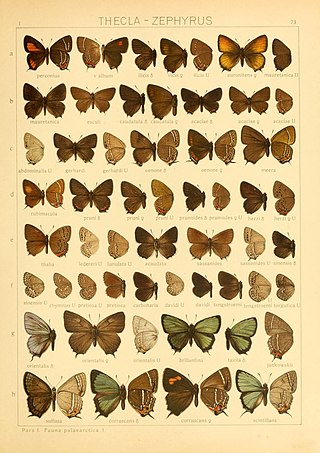
Satyrium ledereri, the orange banded hairstreak, is a butterfly in the family Lycaenidae.

Agrochola lota, the red-line Quaker, is a moth of the family Noctuidae. The species was first described by Carl Alexander Clerck in 1759. It is distributed throughout the whole of Europe except Scandinavia; in Armenia, Asia Minor, and east across the Palearctic to the Altai Mountains and western Siberia.It was introduced to Newfoundland. In the Alps, it rises at altitudes of just over 1500 metres.

Lycaena thersamon, the lesser fiery copper, is a butterfly of the family Lycaenidae. It is found from Eastern Europe, Italy and South-East Europe to Mongolia and North-Western China.

Chazara briseis, the hermit, is a butterfly species belonging to the family Nymphalidae. It can be found in North Africa, southern Europe, Asia Minor, the Caucasus, Kazakhstan, Central Asia through Afghanistan, and north-western China and Tuva. It is found on steppe and in other dry grassy places between 500 and 2,500 meters.
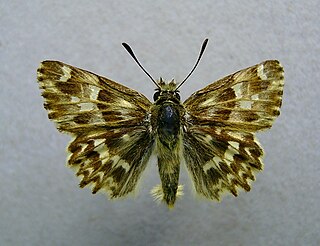
Muschampia lavatherae, the marbled skipper, is a butterfly of the family Hesperiidae. It is found from the Rhine Rift Valley in central Germany up to North Africa and from south-eastern France up to Anatolia.

Epilecta linogrisea is a moth of the family Noctuidae. It is found in Central and Southern Europe, Algeria, Morocco, the Caucasus, Armenia, Turkey, North-Western Iran, Syria, Israel and Lebanon.

Dichagyris musiva is a moth of the family Noctuidae. It is found in some mountainous areas of Europe, Turkey, Armenia, the Caucasus, Anatolia, southern Siberia, Mongolia, Tibet and western China.

Agrochola helvola, the flounced chestnut, is a moth of the family Noctuidae. It was first described by Carl Linnaeus in his landmark 1758 10th edition of Systema Naturae. The species is found in most of Europe, north to Scotland and Fennoscandia up to the Arctic Circle, south to Spain, Sicily, Greece further east to the Middle East, Armenia, Asia Minor, western Turkestan and central Asia up to central Siberia.

Muschampia proto, the sage skipper, is a butterfly of the family Hesperiidae. It is found in Morocco, Algeria, the Iberian Peninsula and southern France.

Pseudochazara anthelea is a species of butterfly in the family Nymphalidae. It is found in Albania, the Republic of Macedonia, Bulgaria, Greece, Turkey and northern Iraq. The males can be easily distinguished from the females by the white base and they are found in dry, stony slopes and gullies, usually on limestone.

The twin-spot fritillary is a butterfly in the family Nymphalidae.
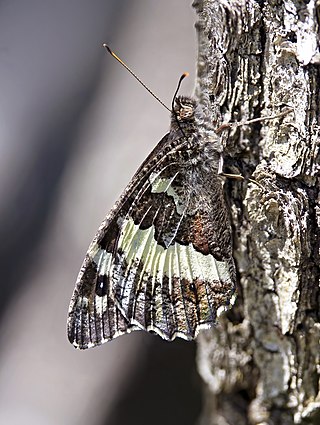
Brintesia is a monotypic butterfly genus in the family Nymphalidae and subfamily Satyrinae. Its one species is Brintesia circe, the great banded grayling.

Pseudochazara beroe is a species of butterfly in the family Nymphalidae. It is found from western Turkey across southern Transcaucasia and the Elburz Mountains to Kopet-Dagh.

Pseudochazara hippolyte is a species of butterfly in the family Nymphalidae. It is confined from the southern Urals across Kazakhstan and northern Tian-Shan to Transbaikalia, Mongolia and northern Tibet.
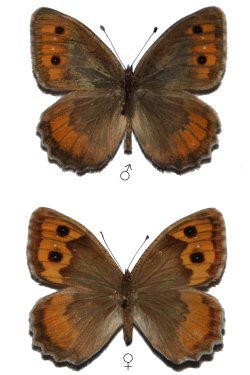
Pseudochazara mniszechii, the tawny rockbrown, is a species of butterfly in the family Nymphalidae. It is confined to Greece, Turkey, northern Iran, Balochistan, and the Caucasus.

Arethusana is a butterfly genus from the subfamily Satyrinae of the brush-footed butterfly family (Nymphalidae). It is composed of only one species, Arethusana arethusa, the false grayling.
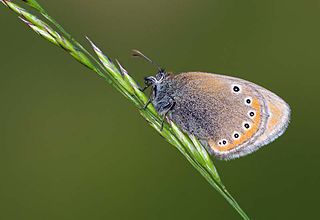
Coenonympha leander, the Russian heath, is a butterfly belonging to the family Nymphalidae. It is found in northern Greece, Hungary, Bulgaria, southern Russia, Asia Minor, Armenia and Iran. The habitat consists of warm grassy areas.
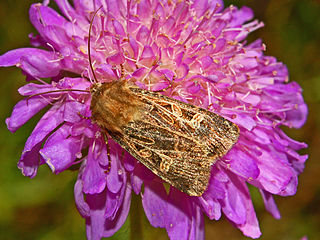
Chersotis alpestris is a moth of the family Noctuidae.




















